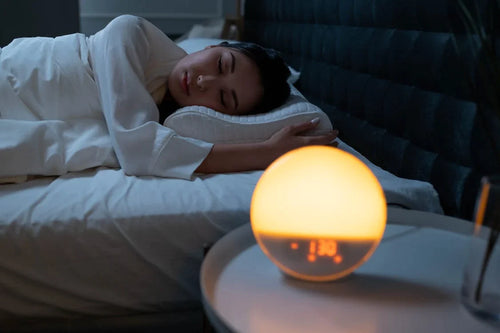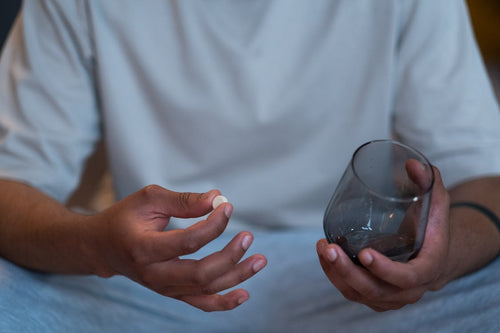For many people, bedtime equals relaxation. Drifting off to dreamland while the body recharges sounds like the perfect way to end the day, right? Unfortunately, for some, this may not be the case.
Have you ever had horrible dreams where you wake up feeling extremely terrible? Or maybe a partner tells you about your unusual behavior while asleep but you always fail to remember.

Image By cottonbro studio From Pexels
You might be suffering from parasomnia, a sleep disorder characterized by sleep disturbances. It includes nightmares, night terrors, sleeptalking, sleepwalking, and the like. Nightmares and night terrors are closely associated that they are sometimes used interchangeably. However, these two have core differences worth noting.
In this article, we’ll compare night terrors vs. nightmares, find out why they happen, and ways to cope. After all, the key to getting quality rest is to understand sleep better. And that includes learning everything about it - the good and the bad.
What Are Nightmares?
They are seemingly realistic dreams that are disturbing and upsetting in nature. They usually follow a menacing story, instead of an abrupt jump scare.

Image By Yan Krukau From Pexels
Some can be highly vivid to the extent that people wake up with extreme sadness or anxiety. They typically come with physiological changes like:
- Elevated heart rate
- Discomfort
- Intense sweating
It will also be difficult to drift back off once you experience them.
Dreams And Nightmares
There are different types of dreams and nightmares are one of them. An intense and unpleasant version of bad dreams, they cause a strong emotional response. They also happen more rarely than bad dreams. It is less likely you wake up startled from a bad dream.

Image By Andrea Piacquadio From Pexels
Why Do We Experience Nightmares?
The causes of nightmares are not certain, but there are triggers and underlying conditions that could increase their risk including:
- Stress
- Anxiety
- Irregular bedtime schedule
- Medications like antidepressants
- Substance abuse or misuse
- Mental health disorders
- Sleep apnea
- Restless legs syndrome
Since having a nightmare is a form of dreaming, the causes of dreams are also similar to these.
What Are Night Terrors?

Image By cottonbro studio From Pexels
People suffering from these may display violent behaviors like flailing, thrashing, and screaming while asleep. Sometimes they will even perform these aggressive acts with eyes wide open despite being completely unconscious.
Now, you might wonder: how long do night terrors last? They usually take seconds to a few minutes though severe episodes may go on for longer.
Night Terrors And Sleepwalking
You might have noticed how night terrors sound exactly like sleepwalking. That is because these two are non-REM sleep parasomnias. They both happen when your brain partially wakes up from deep sleep. Many people who experience night terrors also end up sleepwalking.
Why Do We Experience Night Terrors?

Image By Liza Summer From Pexels
It is hard to single out definite causes of night terrors. Here are the factors that increase their chances of occurring:
- Fever
- Sleep deprivation
- Emotional tension
- Stress
- Conflict
- Shifting bedtime schedule
- Fatigue
- Genetics
- Sleep apnea
Night Terrors Vs. Nightmares: How Are They Different?
As mentioned, both are types of sleep-related disorders called parasomnias. But they’re not exactly the same. Knowing the key differences between the two will aid in overcoming such disturbances.

Image By cottonbro studio From Pexels
Experience
Nightmares awaken people. They are upsetting dreams with a few or every detail you can remember upon waking up.
On the other hand, night terror sufferers are usually unconscious and unaware. And unlike the former, they lack any recollection of the event and often look disoriented when awakened.
Sleep Stage
There are four stages of sleep:
- NREM Stage 1: Transition from waking to sleep
- NREM Stage 2: Light sleep
- NREM Stage 3: Deep sleep or slow-wave sleep
- REM sleep
Both types of disturbance occur at different stages. It is during rapid eye movement (REM) when vivid dreaming takes place.

Image By Craig Adderley From Pexels
Meanwhile, night terrors manifest during non-REM or deep sleep stage. At this point in the cycle, slow brain waves become evident and the excessive arousal of the central nervous system (CNS) will enforce the episode. Brain activity, heart rate, and blood pressure rise in levels.
Timing
A night terror is common in the first half of the night while the other type usually happens in the middle of the night and/or early morning.
Prevalence In Adults
Nightmares are common among adults and nothing of serious concern. We all experience them at some point in our lives. Around 50% to 85% of adults have experienced at least an occasional nightmare according to the American Academy of Sleep Medicine (AASM).
However, severe, frequent nightmares can take a toll on your sleep health and day-to-day life. Seek a professional as this can be a nightmare disorder that needs attention.
Prevalence In Kids

Image By cottonbro studio From Pexels
On the other hand, night terrors in toddlers are not uncommon. There have been reported incidents of night terrors in babies as young as 18 months. Childhood sleep terror affects 56% of kids but its prevalence decreases in adolescence.
The likelihood of such abnormal occurrences as they grow older is less, except for people who end up developing anxiety disorders and Post-Traumatic Stress Disorder (PTSD). Note that repetitive aggressive actions during sleep may be a sign of complex PTSD night terrors.
How They Affect Sleep
These abnormal sleep episodes are often associated with health problems. You might experience poor rest quality, distress, impaired cognitive function, and declining overall health.
Overcoming Nightmares And Night Terrors
These undesirable circumstances can indeed have adverse effects on your life. But the good news is that there are steps you can take to help deal with them.
Stick To A Regular Bedtime Routine

Image By Karolina Grabowska From Pexels
Following a regular schedule always works wonders. The time you sleep and get up should be consistent - as well as the duration. Otherwise, you may experience broken sleep, which makes us remember bad dreams even more.
Be Open About Your Stress And Worries
Do not bottle all your negative emotions up. Give them a healthy release by being open about your anxiety.
You can also go into psychotherapy or talk therapy, a type of mental health treatment where you talk to a therapist. One of the most popular types of psychotherapy widely used by experts is cognitive-behavioral therapy (CBT). They help identify and modify negative thinking.

Image By SHVETS production From Pexels
Types of CBT treatments your doctor might recommend include:
- Imagery rehearsal treatment
- Lucid dreaming therapy
- Progressive deep muscle relaxation
- Hypnosis
Engage In Calming Activities Before Dozing Off

Featuring Weavve’s Signature TENCEL™ Deluxe Set In Fern Green
A relaxed mind paves the way for better sleep. You can try meditating, reading books, and doing breathing exercises before bed. Limit exposure to electronic devices closer to bedtime as well. Increased screen time can also stimulate brain activity, which enhances disturbances.
Cut Back On Caffeine And Alcohol
We all know that caffeine and sleep don’t go well together. Just like prolonged screen time, it contains a substance that amps up brain activity.
Make Your Bedroom As Comfortable And Relaxing As It Can Be

Featuring Weavve’s Signature TENCEL™ Classic Set In Slate Grey
Creating an environment conducive to resting is one of the most effective ways to lessen the frequency and prevalence of parasomnias.
If you’re living in Singapore, it would be best to opt for smooth and breathable bed sheets ideal for all seasons. Pair them with cooling duvets, pillow cases, and other bedding essentials and you’re off to a great night ahead.





































